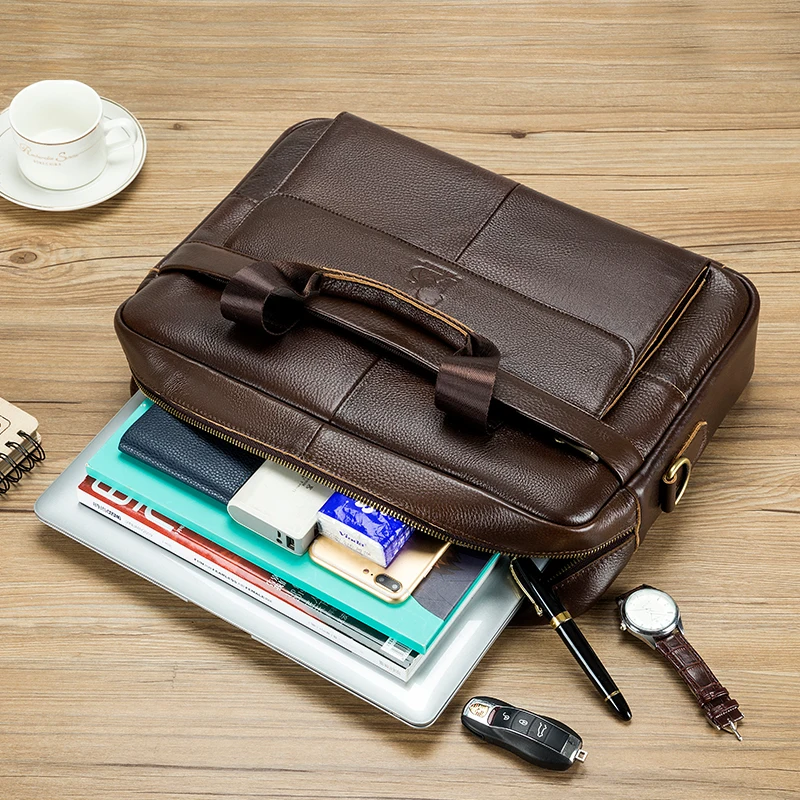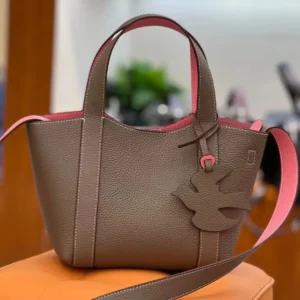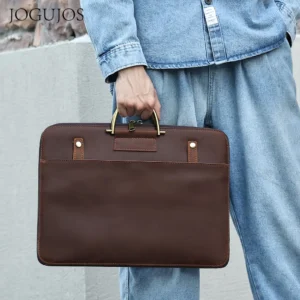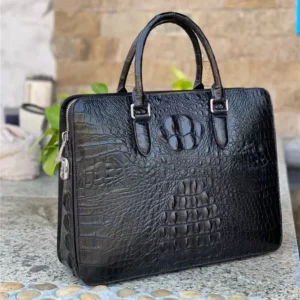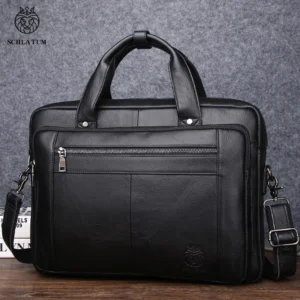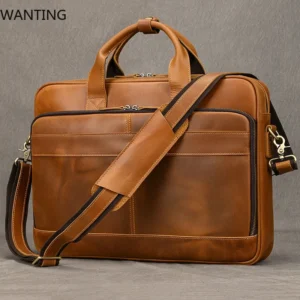Introduction: Understanding the Critical Choice Between Large and Slim Briefcases
Selecting the right briefcase size is one of the most consequential decisions a professional can make regarding their daily work accessories. This choice affects not just what you can carry, but how you carry it, how you’re perceived, and ultimately, how efficiently you navigate your professional day.
The size of your briefcase directly impacts:
- How comfortably you transport your work essentials
- The organization of your professional materials
- Your mobility throughout the workday
- The professional image you project to clients and colleagues
- Your ability to adapt to varying workplace situations
What makes this decision particularly challenging is its deeply personal nature. The “perfect” briefcase size varies dramatically based on your specific profession, daily responsibilities, commute style, physical preferences, and even your professional environment’s unspoken dress code.
Many professionals experience frustration with their briefcase choice only after weeks of daily use, discovering too late that their selection doesn’t align with their actual needs. According to productivity experts, professionals waste an average of 15 minutes daily searching for misplaced items in an incorrectly sized or poorly organized bag—that’s over 60 hours annually of lost productivity.
This guide aims to provide a comprehensive framework for making this critical decision between large and slim briefcases. By the end, you’ll understand how to assess your true capacity needs, consider the professional image implications of each option, and evaluate the practical factors that should guide your choice. The professional leather briefcases guide offers additional perspectives on this important decision.
Assessing Your Briefcase Needs: Key Factors for Size Selection
Before comparing specific briefcase sizes, it’s essential to conduct a thoughtful assessment of your unique professional requirements. This self-evaluation creates the foundation for making the right choice based on your circumstances rather than generic recommendations.
Daily Carry Requirements
Begin by categorizing your daily items into:
- Must-have essentials: Items you use every single day (laptop, planner, specific documents)
- Frequent necessities: Items you need several times per week
- Occasional but important: Items you need infrequently but must have when needed (presentation materials, specific reference documents)
Understanding this hierarchy helps determine your minimum required capacity while accounting for occasional needs.
Commuting and Mobility Considerations
Your transportation method significantly influences optimal briefcase size:
– Public transit commuters often benefit from slimmer profiles for navigating crowded spaces
– Car commuters may prioritize capacity over compactness
– Walking or cycling commuters should consider weight and balance factors
– Frequent travelers need to consider overhead compartment compatibility and multi-day capacity
Professional Environment Expectations
Different workplaces carry different expectations:
– Traditional corporate settings often favor classic, structured briefcases
– Creative industries typically allow more flexibility in size and style
– Client-facing roles may require more formal, refined options
– Field-based professionals need durability and practical capacity
Physical Considerations
Personal physical factors matter significantly:
– Your height and body type affect what size looks proportional
– Upper body strength influences comfortable carrying weight
– Existing back or shoulder issues may limit weight or carrying style options
– Dominant hand and preferred carrying method (handle vs. shoulder strap)
When choosing the perfect leather briefcase, conducting this needs assessment first ensures you focus on options that truly fit your life rather than being swayed by purely aesthetic considerations.
The Daily Carry Inventory: What Your Briefcase Needs to Accommodate
Creating a comprehensive inventory of what you actually carry daily is perhaps the most practical exercise in determining your ideal briefcase size. This inventory should reflect your realistic needs, not an aspirational version of your professional self.
Technology Essentials
- Laptop/Computer: Note exact dimensions and weight (including protective sleeve if used)
- Standard 13” laptop: Approximately 12” × 8.5” × 0.6”
- Standard 15” laptop: Approximately 14” × 9.5” × 0.7”
- Standard 17” laptop: Approximately 16” × 10.5” × 0.8”
- Tablet/E-Reader: Typically 10” × 7” or smaller
- Power supplies and chargers: Often bulkier than anticipated
- External devices: Hard drives, mice, presenters, adapters
- Headphones: Particularly space-consuming if over-ear style
Documents and Paper Materials
The organizing documents in leather bags guide offers detailed strategies, but consider these standard sizes:
– Letter-sized documents/folders: 8.5” × 11”
– Legal pads or documents: 8.5” × 14”
– Standard notebooks/planners: Typically 5” × 8” to 8.5” × 11”
– Business card holders: Typically 4” × 2.5”
– File folders and organizers: Various dimensions based on contents
Professional Tools
- Industry-specific tools: Measuring devices, sample kits, specialized equipment
- Writing instruments: Pens, pencils, markers, styluses
- Calculators or specialized electronic devices
- Business cards (personal and collected)
- Reference materials specific to your field
Personal Necessities
- Wallet, keys, phone (if not carried separately)
- Eyeglasses/sunglasses in cases
- Medications or personal care items
- Small umbrella or compact rain gear
- Reusable water bottle or travel mug
- Snacks or meal containers for long days
Remember that items often take up more space than their basic dimensions suggest due to irregular shapes and the need for protection and accessibility.
Large Briefcases: Features, Benefits, and Ideal Users
Large briefcases typically measure between 16-18 inches in length, 12-13 inches in height, and 5-7 inches in depth. These substantial dimensions provide significant benefits for certain professionals.
Capacity Advantages
The primary benefit of large briefcases is their generous storage capacity, offering:
- Accommodation for larger laptops (15-17 inch screens)
- Space for multiple file folders and document organizers
- Dedicated compartments for technology and accessories
- Room for personal items beyond work essentials
- Ability to carry lunch containers or clothing items
- Flexibility to transport unexpected items that arise during the workday
Organization Features
Large briefcases typically feature:
- Multiple divided sections for document separation
- Numerous interior and exterior pockets
- Padded technology compartments
- File divider systems
- Expandable sections for additional capacity
- Designated spaces for specific accessories
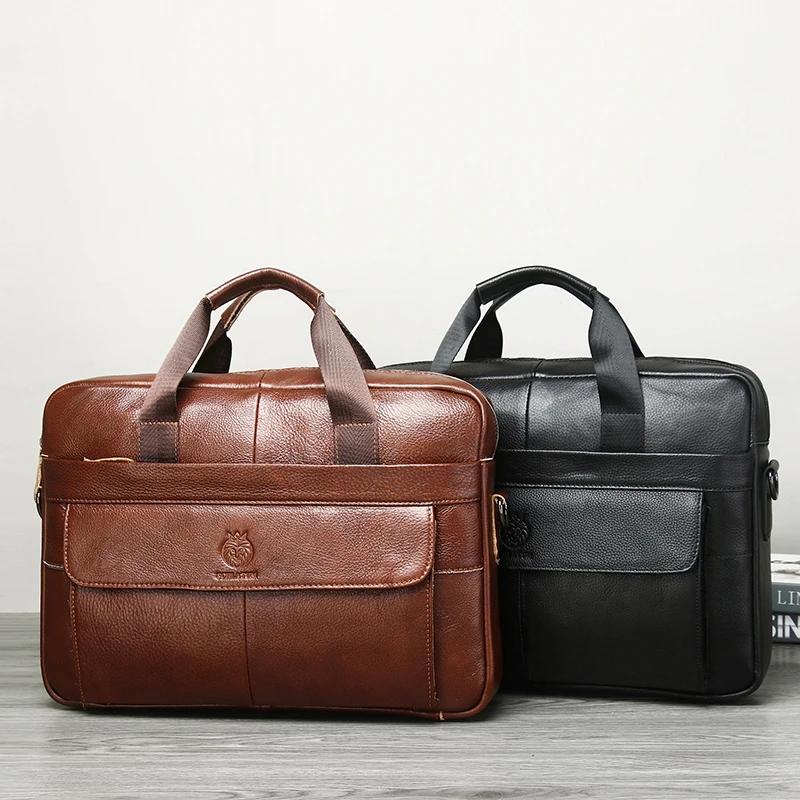
Professional Versatility
Large briefcases excel in scenarios requiring:
- Transportation of presentation materials
- Client meetings requiring extensive documentation
- Day-to-night transitions requiring personal items
- Overnight business trips with minimal additional luggage
- Multi-site workdays requiring complete mobile office functionality
The classic leather briefcases collection offers excellent examples of traditional large-format options that maintain professional elegance despite their size. For professionals seeking comprehensive guidance, the definitive guide to ideal leather briefcases provides detailed insights into selecting the right size and style.
Material and Construction Considerations
Larger briefcases require particular attention to:
- Structural integrity to prevent sagging when fully loaded
- Quality of hardware that must bear additional weight
- Reinforced handles and connection points
- Balanced weight distribution when carried
- Durability of bottom panels and corner protection
Professionals Who Benefit Most from Large Briefcases
Certain professional profiles consistently find greater utility in larger briefcase designs. Recognizing yourself in these descriptions may help clarify your needs.
The Mobile Office Professional
This professional essentially carries a complete workstation daily, requiring:
– Full-size laptop plus tablet
– Extensive charging accessories
– Client files and presentation materials
– Reference materials and resources
– Tools for impromptu workstations in varying locations
The Document-Intensive Specialist
Legal, academic, and financial professionals often need:
– Multiple client or case files simultaneously
– Reference materials and codebooks
– Documents requiring signatures or review
– Materials for multiple meetings throughout the day
– Space for document organization systems
For those requiring substantial document storage, the leather document bag collection offers specialized designs with optimized file organization systems.
The Prepared Professional
Some work environments demand extensive preparedness:
– Healthcare professionals carrying reference materials and specialized tools
– Sales professionals with product samples and promotional materials
– Consultants with materials for various client scenarios
– Professionals who travel between offices with equipment needs
– Educators transporting grading materials and lesson resources
The Day-Long Commuter
Those with extended workdays away from home benefit from:
– Space for meals and personal care items
– Room for weather-appropriate accessories
– Capacity for post-work activities without requiring additional bags
– Organization for both work essentials and personal necessities
Potential Drawbacks of Large Briefcases to Consider
While large briefcases offer undeniable capacity benefits, they come with important considerations that may impact their practicality for some professionals.
Physical Considerations
- Weight factor: Even empty, large briefcases typically weigh 3-5 pounds before adding contents
- Carrying comfort: May cause shoulder or back strain during extended commutes
- Maneuverability challenges: Difficulty navigating crowded spaces, public transportation, or narrow office environments
- Storage requirements: Require more space under desks, in vehicles, or at home
Professional Image Implications
- May appear unnecessarily bulky in minimalist modern offices
- Could seem excessive for professionals in primarily digital roles
- Might present as overly formal in creative or casual environments
- Can sometimes create an impression of disorganization if overpacked
Practical Limitations
- Encourages carrying unnecessary items “just in case”
- Often exceeds airline carry-on dimensional requirements for personal items
- Typically requires two hands when fully loaded
- Less convenient for professionals who frequently transition between walking and seated positions
The collection of top-rated classic leather briefcases includes options that mitigate some of these concerns through thoughtful design and balanced proportions.
Slim Briefcases: Features, Benefits, and Ideal Users
Slim briefcases typically measure between 15-17 inches in length, 10-12 inches in height, and 2-4 inches in depth. This streamlined profile offers distinct advantages for the modern professional.
Streamlined Design Advantages
Slim briefcases excel at:
– Effortless mobility through crowded environments
– Easy storage in tight spaces (under airline seats, beside chairs in conference rooms)
– Reduced weight burden during commutes and travel
– Professional minimalism that complements modern workplaces
– Encouraging thoughtful curation of daily essentials
Organization Innovation
Despite their reduced dimensions, well-designed slim briefcases feature:
– Precision-engineered compartments maximizing limited space
– Dedicated slim laptop sleeves for modern ultrabooks
– Streamlined document organization systems
– Strategic pocket placement for essentials
– Compression systems to maintain slim profile even when full
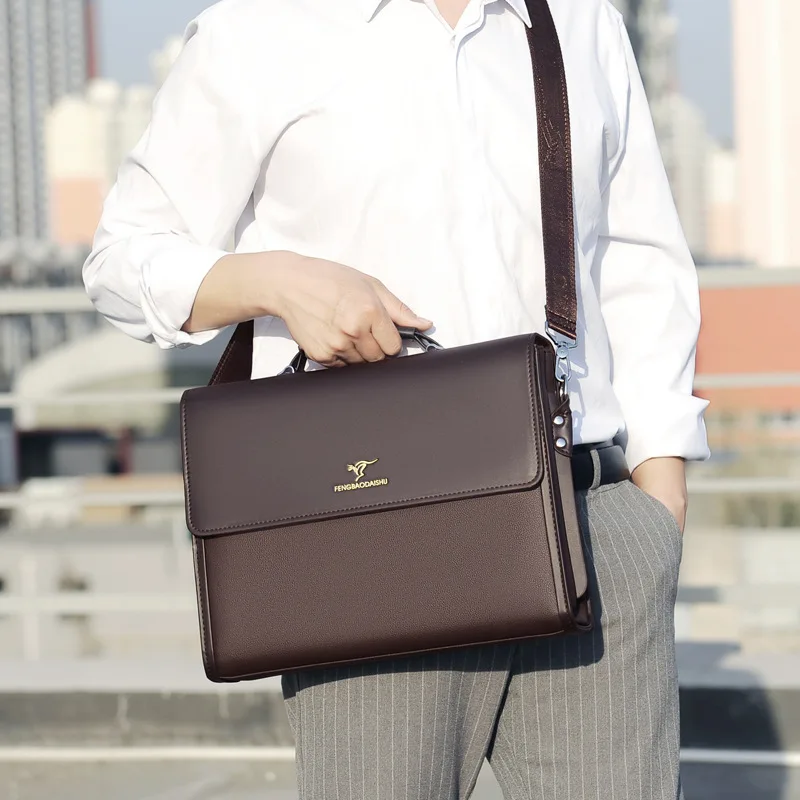
Contemporary Professional Appeal
Slim briefcases particularly shine in:
– Modern corporate environments emphasizing minimalist aesthetics
– Technology companies with digital-first workflows
– Client meetings where agility and efficiency are valued
– Multi-modal commuting situations requiring frequent transitions
– International business travel requiring complementary luggage
The slim leather briefcases collection showcases how modern design can maintain functionality while reducing bulk. For professionals concerned about durability in slimmer profiles, the durable leather briefcase options guide addresses how quality materials can provide longevity despite reduced dimensions.
Material Selection Benefits
Slimmer profiles often allow for:
– Higher-grade materials within similar price points
– More refined hardware and accents
– Enhanced attention to detail and finishing
– Lighter weight options without sacrificing durability
– More focus on aesthetic considerations
Professionals Who Benefit Most from Slim Briefcases
Certain professional profiles consistently find greater satisfaction with slim briefcase designs. Identifying with these descriptions may help clarify your needs.
The Digital-First Professional
This modern professional primarily works with:
– Ultrabook or thin laptop (13-14 inches)
– Tablet or e-reader
– Minimal paper documents
– Cloud-based file access rather than physical files
– Digital presentation capabilities
The Urban Navigator
Professionals with challenging commutes value:
– Effortless movement through crowded transit systems
– Comfortable carrying during walking portions of commutes
– Easy management alongside other bags or items
– Space-efficient storage at workstations
– Reduced weight during extended carrying periods
The Meeting-Focused Executive
Leaders who move between numerous meetings benefit from:
– Professional appearance without bulky encumbrance
– Easy transitions between sitting and standing
– Quick access to essential materials
– Non-intrusive presence in conference rooms
– Elegant statement of efficiency and purpose
The men’s slim leather briefcase collection offers options particularly designed for professionals seeking refined minimalism in various professional contexts.
The Minimalist Professional
Those embracing streamlined work approaches appreciate:
– Physical reinforcement of “less is more” philosophy
– Forced curation of true daily essentials
– Reduced physical and mental burden of excessive options
– Elegant simplicity that complements minimalist lifestyles
– Focus on quality over quantity in professional tools
Potential Drawbacks of Slim Briefcases to Consider
While slim briefcases offer compelling advantages for mobility and style, they present certain limitations that deserve careful consideration.
Capacity Constraints
- Limited space requires constant prioritization of carried items
- Typically accommodates laptops only up to 15 inches (often 13-14 inches optimal)
- Minimal room for physical documents and folders
- Challenges in carrying both work and personal necessities
- Little flexibility for unexpected items or changing daily needs
Organization Challenges
- Fewer compartments and dividers than larger counterparts
- Potential for contents to appear jumbled despite organization attempts
- Difficulty separating documents of different types or projects
- Limited protection for fragile items when packed tightly
- Restricted access when retrieving items in confined spaces
Professional Limitations
- May appear insufficient in traditional document-heavy environments
- Could seem underprepared in settings expecting comprehensive materials
- Potentially inadequate for full-day offsite work requiring multiple resources
- Often impractical for business travel exceeding one day
- May require supplemental bags for certain situations
The defining best leather briefcases resource addresses how material quality becomes even more critical in slim designs where structural integrity must be maintained with less material.
Side-by-Side Comparison: Large vs. Slim Briefcase Features
This comprehensive comparison highlights the key differences between large and slim briefcases across essential criteria to facilitate direct decision-making.
| Feature | Large Briefcases | Slim Briefcases |
|---|---|---|
| Typical Dimensions | 16-18” × 12-13” × 5-7” | 15-17” × 10-12” × 2-4” |
| Laptop Capacity | Up to 17” laptops | Typically 13-15” laptops |
| Document Capacity | Multiple full folders, binders | Limited folders, few documents |
| Weight (Empty) | 3-5 pounds | 2-3 pounds |
| Weight (Loaded) | 8-12+ pounds | 5-8 pounds |
| Organization | Multiple compartments, dividers | Fewer compartments, minimal dividers |
| Professional Image | Traditional, comprehensive | Modern, efficient |
| Commuting Comfort | Lower for long distances | Higher for long distances |
| Best Uses | Document-intensive work, full-day mobile office | Meeting-focused work, digital workflows |
| Travel Suitability | Overnight trips possible | Day trips only |
| Space Efficiency | Requires significant storage space | Fits easily in tight spaces |
| Access to Contents | Easier access to multiple items | Sometimes restricted by tight packing |
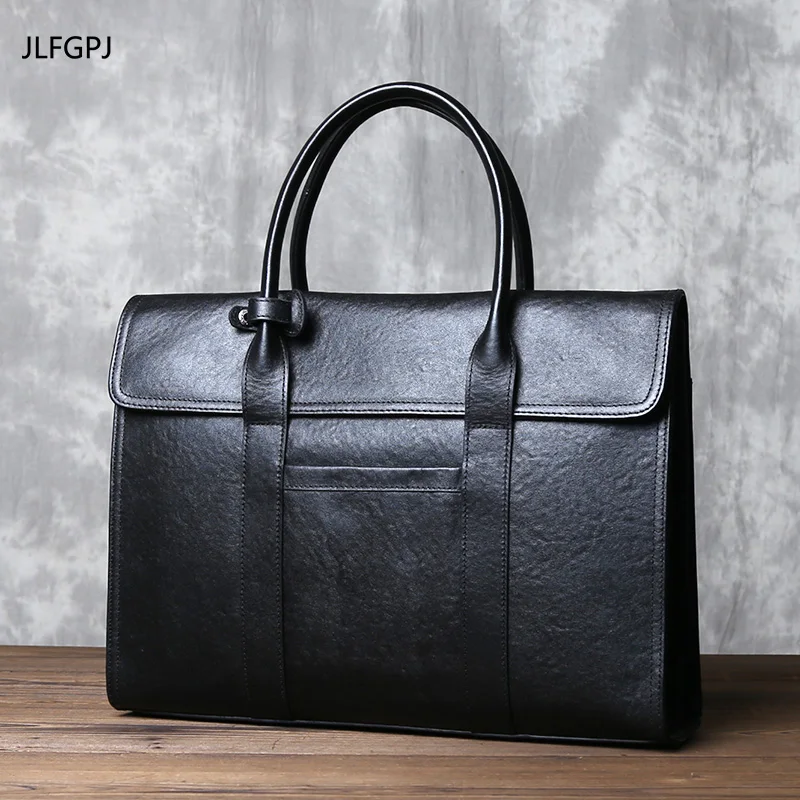
The classic leather briefcase comparison provides additional detailed analysis of how these differences manifest across various professional scenarios.
Essential Features for Any Briefcase: Size-Independent Quality Markers
Regardless of whether you choose a large or slim briefcase, certain quality indicators should be non-negotiable. These features ensure longevity, functionality, and satisfaction regardless of size selection.
Material Excellence
- Leather quality: Full-grain or top-grain leather provides superior durability and develops character over time
- Canvas and synthetics: Look for high denier counts and water-resistant treatments
- Interior lining: Durable, stain-resistant materials that won’t tear or pill
- Reinforced stress points: Additional material or stitching where wear occurs most
Hardware Durability
- Zippers: YKK or similar quality brands with smooth action and corrosion resistance
- Buckles and clasps: Solid metal construction with secure closing mechanisms
- Handle attachments: Reinforced connections to the bag body
- Shoulder strap fixtures: Swivel capability and stress-tested connections
The classic laptop briefcase collection demonstrates how these quality elements can be incorporated into various sizes and styles. Understanding the difference between full-grain vs top-grain leather helps in evaluating material quality regardless of briefcase size.
Functional Design Elements
- Padding: Appropriate protection for electronic devices
- Water resistance: Either through material selection or additional treatments
- Accessible pockets: Thoughtfully placed for frequently used items
- Balance: Even weight distribution when carried
- Stability: Ability to stand upright when placed down
- Comfortable carrying options: Both handle and shoulder strap designs
Finding the Perfect Balance: Hybrid and Expandable Options
For professionals struggling to choose between large and slim profiles, hybrid and expandable designs offer compelling alternatives that adapt to varying needs.
Expandable Design Solutions
Modern briefcase engineering has created innovative expandability through:
– Accordion-style expansion sections that add 1-3 inches of depth when needed
– Zipper-controlled expansion panels that maintain clean lines when not extended
– Magnetic compression systems that allow variable capacity
– Modular compartments that can be attached or removed based on daily requirements
– Convertible designs that transform between messenger and briefcase formats
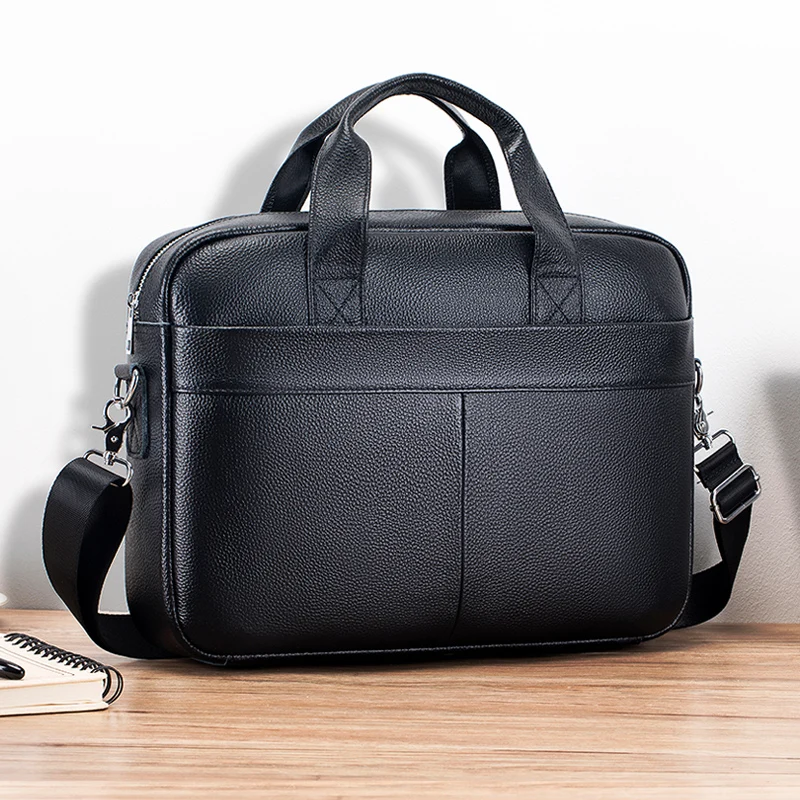
The Benefits of Adaptability
Expandable briefcases particularly benefit professionals who:
– Have significant variation in their daily carrying requirements
– Travel occasionally but primarily work in office environments
– Transition between document-heavy and digital-focused workdays
– Want to maintain a consistent professional image despite varying functional needs
– Prefer investing in one quality piece rather than multiple specialized bags
Evaluating Hybrid Options
When considering expandable briefcases, assess:
– The elegance of the expansion mechanism (does it maintain aesthetic appeal when expanded?)
– Weight penalties associated with expansion features
– Organization consistency between standard and expanded configurations
– Range of expansion (is it sufficient for your variable needs?)
– Default profile (does it primarily present as your preferred size when not expanded?)
The affordable quality leather briefcases collection includes several expandable options that balance adaptability with reasonable investment.
Transporting Technology: Laptop and Device Considerations
Technology protection represents one of the most critical functions of modern briefcases, with requirements varying significantly based on the devices you carry.
Laptop Compatibility Fundamentals
- Proper sizing: Allow approximately 0.5-1 inch of additional space beyond laptop dimensions
- Dedicated compartments: Separate from main document areas to prevent damage
- Padding requirements: Minimum 0.25-0.5 inch padding on all sides, particularly bottom
- Secure closure: Prevents laptop shifting during transport
- Accessibility: Easy retrieval without disturbing other contents
Finding the perfect leather bag for your laptop requires matching your specific device dimensions to appropriate compartment specifications.
Multiple Device Accommodation
Modern professionals often carry combinations of:
– Laptop plus tablet
– Multiple tablets for different functions
– E-readers alongside other devices
– Smartphones requiring separate protection
– Peripheral devices requiring organization
Technology Accessory Organization
Effective briefcases provide:
– Cable management systems to prevent tangling
– Power bank storage with charging access
– Padded pockets for external drives and adapters
– Quick-access compartments for frequently used accessories
– Protection from potential liquid damage in other compartments
The slim leather laptop briefcase collection demonstrates how even minimalist designs can provide comprehensive technology protection.
Men's Classic Leather Briefcase, Slim Leather Laptop Briefcase, Slim Leather Portfolio Briefcase
$93.67 Select options This product has multiple variants. The options may be chosen on the product pageBrown Leather Work Tote, Large Leather Work Tote
$194.38 Select options This product has multiple variants. The options may be chosen on the product pageClassic Laptop Briefcase, Men's Classic Leather Briefcase, Slim Leather Attache Case
Price range: $353.50 through $360.81 Select options This product has multiple variants. The options may be chosen on the product pageBlack Leather Briefcase, Leather Document Bag, Men's Classic Leather Briefcase
Genuine Crocodile Leather Executive Briefcase with Password Lock – Premium Business Document Carrier$1,201.87 Select options This product has multiple variants. The options may be chosen on the product pageBlack Leather Briefcase, Classic Laptop Briefcase, Men's Classic Leather Briefcase, Slim Leather Laptop Briefcase
$228.72 Select options This product has multiple variants. The options may be chosen on the product pageBrown Leather Briefcase, Classic Laptop Briefcase, Crazy Horse Leather Satchel, Men's Classic Leather Briefcase
Price range: $172.15 through $200.02 Select options This product has multiple variants. The options may be chosen on the product page
Decision Framework: Matching Your Profile to the Right Briefcase Size
This structured approach helps translate your personal assessment into a concrete briefcase size decision.
Step 1: Inventory Assessment
Create two separate lists:
– Daily Essentials: Items you absolutely must carry every day
– Frequent Additions: Items you carry 2-3 times per week
Physically gather these items to understand their collective volume.
Step 2: Priority Ranking
Rank these factors in order of personal importance:
1. Maximum capacity
2. Carrying comfort
3. Professional image
4. Organizational features
5. Mobility and convenience
Step 3: Career Context Evaluation
Consider:
– Industry standards and expectations
– Client perception in your specific field
– Office environment and storage limitations
– Travel requirements of your position
– Future career trajectory (will needs change soon?)
Step 4: Practical Testing
If possible:
– Temporarily carry your daily items in bags of different sizes
– Notice when capacity feels insufficient versus excessive
– Pay attention to fatigue after carrying different weights
– Observe how different sizes affect your mobility
Step 5: Compromise Assessment
Determine which compromises you’re most willing to make:
– Carrying less to gain mobility
– Adding weight to ensure preparedness
– Occasional capacity limitations for better daily comfort
– Multiple specialized bags versus one all-purpose solution
The professional leather briefcase guide provides additional context for how these decisions impact your overall professional presentation.
Professional Image: How Briefcase Size Influences Perception
Your briefcase communicates subtle but important messages about your professional identity and approach.
Industry-Specific Perceptions
Different professional environments interpret briefcase size through different lenses:
– Traditional corporate settings: Larger briefcases often signal seniority and substantial responsibility
– Creative industries: Slimmer profiles typically suggest modern thinking and digital fluency
– Legal and financial sectors: Document capacity remains an expected professional tool
– Technology and startups: Minimalism often aligns with efficiency and innovation values
– Client services: Size appropriateness depends on client expectations and meeting functions
Situational Considerations
The same briefcase can be perceived differently in varying contexts:
– First impressions: Size appropriateness matters most when establishing new relationships
– Daily office use: Practical functionality typically outweighs perception among familiar colleagues
– Client presentations: Briefcase should reflect the nature of the meeting (document-heavy vs. discussion-focused)
– Business travel: Appropriate sizing demonstrates travel savvy and preparation
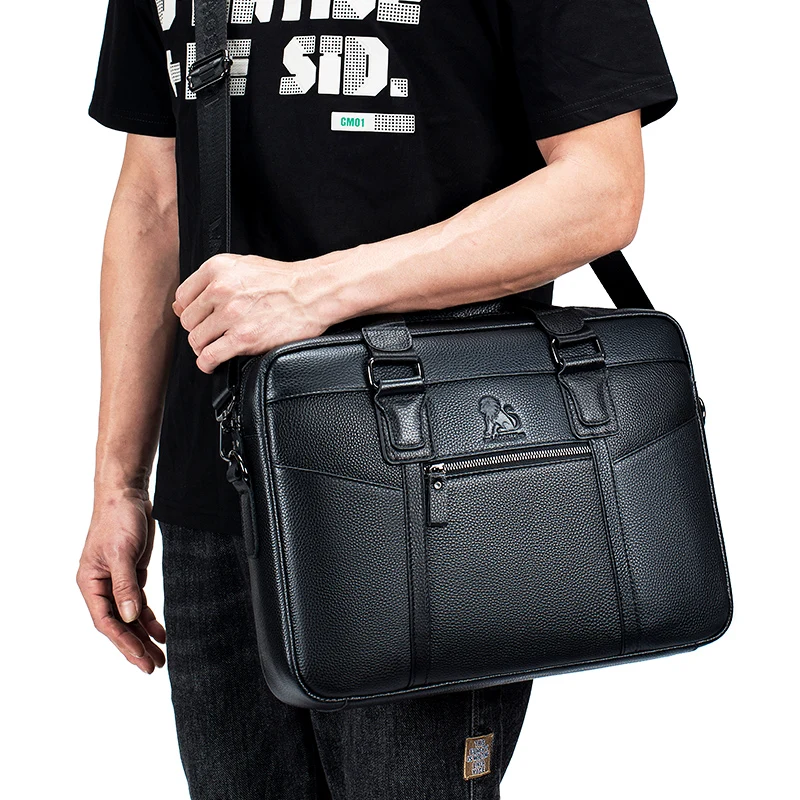
Alignment with Professional Positioning
Your briefcase size should reflect:
– Your role’s specific requirements
– How you want to be perceived professionally
– The balance between preparation and efficiency that you value
– Your personal comfort needs during the workday
– Your authentic professional style
The definitive guide to classic leather briefcases explores how these image considerations have evolved while maintaining core professional principles.
FAQ: Common Questions About Briefcase Size Selection
Q: How do I know if my laptop will fit comfortably in a specific briefcase?
A: Measure your laptop’s dimensions (length × width × depth) and add approximately 0.5-1 inch to each dimension to ensure comfortable fit. Always check the interior compartment dimensions, not just the exterior briefcase measurements.
Q: Will a slim briefcase make me appear unprepared in traditional business settings?
A: Not if selected thoughtfully. Choose a slim briefcase with refined materials and professional styling. Quality and appropriate formality matter more than size in establishing credibility.
Q: How much weight is considered reasonable to carry daily in a briefcase?
A: Ergonomic experts recommend limiting daily carried weight to no more than 10-15% of your body weight to prevent strain. For most adults, this means keeping your loaded briefcase under 10-12 pounds for comfortable daily use.
Q: Are there alternative options if I occasionally need extra capacity?
A: Consider supplementary solutions like portfolio folders for occasional document transport or compact laptop-only cases for minimalist days. The large leather work tote collection offers alternatives for days requiring exceptional capacity.
Q: How do I prevent overpacking a large briefcase?
A: Implement a regular “briefcase audit” by emptying contents weekly and critically evaluating each item’s necessity. Create designated spaces for essentials and resist filling additional space simply because it’s available.
Q: Can briefcase size affect promotion prospects or professional advancement?
A: While seemingly minor, inappropriate briefcase sizing can subconsciously influence perception. Size should reflect role-appropriate preparation and efficiency—oversized may suggest disorganization while undersized might imply insufficient preparation in document-heavy fields.

